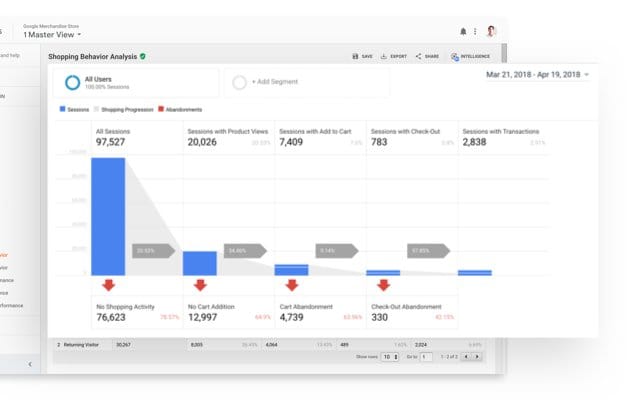Sections
Grow Your Business with Custom Reporting and Alerts
Over the past few years, analytics has become a buzzword for CEOs and digital marketers seeking to grow their brands. With all the tools, resources, and technology marketers have at their disposal, it’s no surprise that higher-ups are using data to drive big-picture decisions, particularly when it comes to the brand’s SEO, email marketing, and social media strategies.
Reporting lets you quickly discover answers to important questions like, Is your latest email trending? What are the most popular keywords searched for relative to your brand? How is your social media traffic/revenue doing overall?
“The bottom line is reporting provides key insights into how your marketing efforts are bringing revenue and profit to your business,” says Emily Briggs, Your Marketing People’s reporting manager. “With the data in front of you, you can then decide to duplicate your successes or to find better avenues for improvement. If you don’t use already utilize reporting on your website, now is the time to start.”
The good news? The best industry tool to help you dive in is probably already installed on your website—and it’s free! Google Analytics tracks everything from the most popular pages on your site to page speed to what keywords you’re ranking for and more. Setup is a simple 1-2-3 process: sign up, add the tracking code to your website, and start learning about your audience.
But you can take it a few steps further by customizing your reporting and adding custom alerts and triggers to safeguard you from issues that may arise. Here, we discuss the greatest benefits of custom reporting tools and alerts in Google Analytics when growing your brand.
Fine-Tune Your Reporting
Standard reporting features in Google Analytics offer surface-level data. You’ll get a glimpse at the overall picture of your business and have the ability to track certain campaigns or initiatives. If you want to go deeper and discover the backing behind your business decisions, customized reports are probably a better fit for your needs.
Google offers a variety of customizable reporting structures and visualizations to help you quickly analyze what your data is really telling you. Advertising reports can help you link your audience data insights with your Google Ads to help you understand and improve your paid search efforts.
Behavior reports aid in your understanding of how visitors interact with your site. Behavior Flow Chart shows their journeys from page to page. Site Search shows who used your site’s search function and the keywords they used. Site Speed displays how long it took for users to interact with your content and pages.

Photo courtesy of Google Analytics

See What You Want to See
Set up custom reports and alerts so you’re always in-the-know of the happenings in your business.
3 Reasons to Adopt Custom Reporting
- Stakeholders get a bird’s eye view of the overall progress. Looking at revenue numbers isn’t enough. The data will let you know what’s working so you can duplicate the progress, or what’s simply not working so you can turn your efforts and spend elsewhere. Reports allow you to identify areas for quick wins as well as long-term goals.
- Reduce data overload and analysis paralysis. Access to so much data can be wonderful yet overwhelming. And honestly, your brand may not need to regularly see some of the data that comes standard. Perhaps you’re most interested in the customer journey and ways to improve the sales funnel, or you need to identify your target demographic by location or age.
- Choose the metrics and dimensions that make the most sense for your business. No two businesses are exactly alike, so standard reporting won’t tell you everything you want to know about your audience. With custom reports, you can choose the metrics (i.e. Audience, Acquisition, Conversion, etc) and dimensions (i.e. defining where you want your report to focus) so you can make the best decisions for your brand.
How to Set Up Custom Reports:
- Go to the Reports tab, and click Customization > Custom Reports > +New Custom Report
- Enter the title, add an optional report tab.
- Select report type: Explorer, Flat Table, Map Overlay, or Funnel.
- Define your dimension and metrics (add filters here to limit the report to specific dimensions)
- Decide where the report should appear (i.e. who has access to the report)
Stay “In the Know” With Notifications
Analyzing data is important for your bottom line, but it’s also time-consuming. To make the analytics routine easier, consider adding custom alerts and triggers to your reporting. You’ll be notified each time something important occurs on your website.
Alerts and triggers reduce the time your employees need to spend checking your analytics. Businesses can set up custom alerts for just about anything, including sudden spikes or drops in traffic, revenue, transactions, page load time, goal conversions (leads, etc.), and more.

One of the biggest benefits of analytics alerts and triggers is that you are notified in real-time. Is a broken link on a sales page potentially making you lose revenue? If you’ve set up alerts for this, you can fix the problem immediately instead of finding out about it weeks later.
How to Set Up Custom Alerts:
- Go to the Reports tab, click Customization > Custom Alerts
- Click Manage custom alerts and click New Alert
- Fill in: Alert Name; Apply to (which reporting views you want to apply the alert to); and Period (the frequency at which the alert can be generated, i.e. day, week, month)
- Select the box to receive an email (or mobile alert for US residents) when the alert is generated
- Select Alert Conditions (dimension, metric to which the alert applies)
How to Set Up Custom Triggers:
- In Google’s Tag Manager, click Triggers > New
- Click Trigger Configuration and choose the Custom Event trigger type.
- Enter the event name, then select “use regex matching” to allow this field to handle regular expressions.
Advanced Reporting for a Successful Business
Google Analytics’ custom reporting and alerts not only give you key insights into what’s working well, they also alert you to issues. Some problems that arise on your website or app end up being related to a tracking issue. Perhaps a recent update removed the tracking? Your custom reports and alerts will make you aware of what’s happening so you can come up with a quick solution.
Need help implementing custom reports and alerts into your business plan? Your Marketing People is here to help! Pricing for custom reporting setup and implementation starts at $250. Contact us to get started today.
Custom Reporting and Alerts
Knowing is half the battle. Get pinged immediately when something is out of the ordinary.







